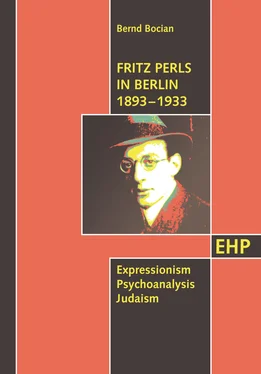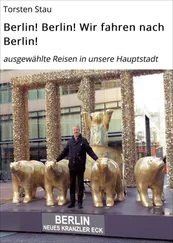6.5.1 Attending Wilhelm Reich’s »Technical Seminar.« Resistance and Character Analysis
6.5.2 Orgasm and the Genital Character
6.6 A New Beginning in Berlin. Medicine and Psychoanalysis
6.6.1 Working as a Physician
6.6.2 Learning and Suffering at the Psychoanalytic Institute
6.7 The Bauhaus Concept
6.8 Political Polarization, Dialectics, and Alienation
6.8.1 Perls Attempts to Take a Class Position
6.8.2 Georg Lukács. Hegel, Dialectics and the Contextual Method
7. The Concept of Totality
7.1 Totality on the Left and on the Right
7.2 The Transitional Gestalt and the Figure of Tension
7.3 The Individualism of Lebensphilosophie
8. At the Berlin Psychoanalytic Institute. 1930–1933
8.1 Siegfried Bernfeld. The Gestalt Experience and »Social Place«
8.2 Wilhelm Reich. Politics and the Continuing Development of Active Technique
8.2.1 Neocatharsis and Physical Resistance. From Ferenczi to Fenichel and Reich
8.2.2 Masochism and Politics. Bernfeld and Freud against Reich
9. Hunger, Chewing, Growing. Intellectual Approaches of One’s Own in Opposition to the Power of Psychoanalytic Interpretation and the German Tradition of Obedience
9.1 Ernst Bloch. The Hunger Drive, Self-Extension, and the Dawning of the New
10. Trauma Therapy and Figures of Steel
10.1 The Trauma of War and »Acting Out« Therapy
10.2 Armored Men. Men of Steel
11. Perls’s Lessons from the End of the Weimar Republic
11.1 Dr. Perls and the »Marxist Workers’ School« (MASCH)
11.2 Left Freudians
11.3 Splitting instead of Integration. The Failure of the »Anti-Fascist Action«
11.4 The Marginalization of Wilhelm Reich
11.5 Endangerment and Escape
11.5.1 Confluence and Projections Can Cost Lives
12. Exodus and Death
12.1 The Fate of the Perls Family in Berlin
II. THE EXPERIENCES OF THE GERMAN-JEWISH AVANT-GARDE. THEIR TOPICALITY TODAY
1. German-Jewish Experiences
1.1 Kafka’s Four-Legged Beings
1.2 Universalism, Loneliness, Modernity
1.3 Gestalt Assimilation Theory. A Biological-Sociological Resistance Metaphor
2. Autonomy instead of Auschwitz: Confluence Kills
3. Perls’s Topicality: Identity Work
3.1 Nietzsche and the Artists
3.2 The Multiplicity of the Subject
3.3 Kafka and Perls. »But« versus »And«
4. Mephistopheles As a Ferment for Integration. Perls’s Leitmotiv
4.1 There Is No End to Integration
4.2 Mephistopheles. Disturbing and Complementing
5. Conclusion. Expressionists, Émigrés, and Those in Search of a Homeland
Annotations
APPENDIX
Institutions and Archives Consulted
References
Index
Dedicated to the memory
of my beloved wife Gabriella Barisione
(May 13, 1958 – November 26, 2008)
and to our daughter Mirta
Deutsche Vereinigung für Gestalttherapie: Greeting
This volume is dedicated to Fritz Perls’s impact on Gestalt therapy. In its breadth and depth, the account reveals the multifaceted background and its significance for Perls’s life and the development of Gestalt therapy.
The roots of Gestalt therapy lie in the Germany of the 1920 th. After Fritz and Laura Perls were forced to flee Nazi Germany they had to plant and nurture these roots on different soil.
Bernd Bocian’s well-informed elucidation exemplifies the variation and breadth of the cultural, political and historical embedment. The later development of Gestalt therapy is based on what he describes so thoroughly, so vividly and with such versatility.
The pleasure of reading this differentiated and colorful account should not be limited to German readers, and the DVG-Board wholeheartedly supports the publication of an English edition of this book.
We are particularly pleased that the story of Fritz Perls’s life in Berlin is ready to be presented at the 10 thEuropean Gestalt Conference in Berlin!
Berlin, July 2010
Veronica Klingemann and Judith Wurm-Beissel
for the board of the German Association for Gestalt Therapy
(Deutsche Vereinigung für Gestalttherapie e.V. - DVG)
European Association for Gestalt Therapy: Greeting
When I read this book for the first time in German, I realized that it was an important work and should also be made available in English.
Many professionals hold the opinion that Gestalt therapy originated in the USA with the publication of »Gestalt Therapy« (Perls, Hefferline, Goodman, 1951) – or possibly with the publication of »Ego, Hunger and Aggression« (Perls, 1947) which was written in South Africa, developed by Laura and Fritz Perls out of psychoanalysis, and in that sense paved the way for Perls’s new therapeutic approach. But Fritz Perls had previously spent 40 years of his life in Germany and had received his education in Berlin, the city of his birth. Drawing on our knowledge of field influences, we can easily imagine what an enormous impact the cultural environment of this era must have had on him (and on Laura Perls) as well as on the later conception of Gestalt therapy.
For several years, there has been an interest within the international Gestalt community in rediscovering and reflecting on Gestalt therapy’s European roots. Bernd Bocian has not merely made a further contribution to the biography of Fritz Perls. His detailed descriptions of the historical, cultural, and political events of those years provide more. This book also sheds an interesting historical light on the realities of living in Berlin during the four decades spanning the turn of the 19 thand 20 thcenturies, World War I, and the period between the world war and the rise of Nazi fascism.
Although Fritz Perls represents the figure in this story, the book concentrates on his surroundings and the age in which he lived, on the impact of its culture and politics, on the very specific life that German Jews led in Berlin, and on their integration into Germany. For many of them, being a German represented a more pregnant figure than the figure of being Jewish. Many of them considered themselves Jewish Germans, and not German Jews. It was all the more shocking for them when they realized that from the perspective of Nazi ideology they were pregnant in a different sense: the Nazis viewed them as German Jews and proceeded to declare war against Judaism. Many Jewish Germans could not understand how it was possible for such a change to occur and simply did not believe it, until it was too late to escape.
Culturally and politically interested readers, psychoanalysts, and, of course, Gestalt therapists will discover a multitude of fascinating new aspects of this era. The author impressively illustrates the influence of Fritz Perls’s life on his later conception of Gestalt therapy. Readers will see how right-wing and left-wing politicians adopted a holistic viewpoint for ideological purposes. Perls’s emphasis on autonomy that supports social action rather than on becoming confluent with »the whole,« that is, with the »greater idea« or the »higher gestalt,« was very much influenced by his biographical experiences during the age of German fascism. This experience made a positive contribution to his later orientation. It led to his decision to leave South Africa as fascism (Apartheid) emerged there, as well as his decision to leave the USA at a time when fascist tendencies were on the ascendant and Richard Nixon was elected president. Perls disagreed with Maslow, who transformed humanistic psychology into transpersonal psychology exactly at the time when a political shift toward fascism was taking place in America.
The political dimension of Fritz Perls’s approach is still very topical today. Since Gestalt therapy is often combined with esoteric elements, a more indepth discussion should take place with respect to the two different kinds of holistic thinking, namely, that seen in Perls’s concept of Gestalt therapy and the other as conceived by transpersonal psychology and the esoteric schools. Such combinations of Gestalt therapy and esotericism raise a question: to what extent is the view of man espoused by a rational, emancipatory psychotherapy compatible with a regressive, esoteric-evolutionary approach, or are these views of man contradictory and therefore incompatible?
Читать дальше











